Drawing on current business publications find an article in
Solution
FRBSF Economic Letter
After the First Rate Hike 2016-01
The Federal Reserve has started the process of raising interest rates, in line with ongoing improvement in U.S. economic conditions. The path for subsequent interest rate increases, however, is likely to be shallow compared with past tightening cycles. This reflects in part growing evidence that the new normal for interest rates is lower than in the past. The following is adapted from a presentation by the president and CEO of the Federal Reserve Bank of San Francisco to the California Bankers Association in Santa Barbara, California, on January 8.
Reducing Poverty via Minimum Wages, Alternatives
2015-38
David Neumark
December 28, 2015
Setting a higher minimum wage seems like a natural way to help lift families out of poverty. However, minimum wages target individual workers with low wages, rather than families with low incomes. As a result, a large share of the higher income from minimum wages flows to higher-income families. Other policies that directly address low family income, such as the earned income tax credit, are more effective at reducing poverty.
The Effects of Minimum Wages on Employment
2015-37
David Neumark
December 21, 2015
The minimum wage has gained momentum among policymakers as a way to alleviate rising wage and income inequality. Much of the debate over this policy centers on whether raising the minimum wage causes job loss, as well as the potential magnitude of those losses. Recent research shows conflicting evidence on both sides of the issue. In general, the evidence suggests that it is appropriate to weigh the cost of potential job losses from a higher minimum wage against the benefits of wage increases for other workers.
Dancing Days Are Here Again: The Long Road Back to Maximum Employment
2015-36
John C. Williams
December 7, 2015
The U.S. economy is on the cusp of full health, supported by highly accommodative monetary policy in recent years. The labor market is nearing maximum employment. Inflation remains too low, but measures of its underlying trend suggest that it is not far from the Fed’s 2% target. With real progress toward these goals, the conversation has turned to normalizing policy. The following is adapted from a presentation by the president and CEO of the Federal Reserve Bank of San Francisco to community leaders in Portland, OR, on December 2.
Global Fallout from China’s Industrial Slowdown
2015-35
Mark Spiegel
November 23, 2015
China’s demand for imports helps support the global economic recovery, so China’s recent economic slowdown has caused international concern. China’s slowdown is concentrated in the industrial sector, while its emerging service sector has shown much new strength. However, China’s service sector is relatively closed and relies only modestly on imports. Accordingly, service sector growth is unlikely to offset the adverse implications of a slowing China for global trade.
What’s Different about the Latest Housing Boom?
2015-34
Reuven Glick, Kevin J. Lansing, and Daniel Molitor
November 16, 2015
After peaking in 2006, the median U.S. house price fell about 30%, finally hitting bottom in late 2011. Since then, house prices have rebounded strongly and are nearly back to the pre-recession peak. However, conditions in the latest boom appear far less precarious than those in the previous episode. The current run-up exhibits a less-pronounced increase in the house price-to-rent ratio and an outright decline in the household mortgage debt-to-income ratio—a pattern that is not suggestive of a credit-fueled bubble.
Are Wages Useful in Forecasting Price Inflation?
2015-33
Rhys Bidder
November 2, 2015
Labor costs constitute a substantial share of business expenses, and it is natural to expect wages to be an important determinant of prices. However, research suggests that wages do not contain much useful information for forecasting price inflation that is not available from other indicators. Therefore, one should not infer too much from recent wage data regarding the future path of inflation.
Why So Slow? A Gradual Return for Interest Rates
2015-32
Vasco Cúrdia
October 12, 2015
Short-term interest rates in the United States have been very low since the financial crisis. Projections of the natural rate of interest indicate that a gradual return of short-term interest rates to normal over the next five years is consistent with promoting maximum employment and stable inflation. Uncertainty about the natural rate that is most consistent with an economy at its full potential suggests that the pace of normalization may be even more gradual than implied by these projections.
The Economic Outlook: Live Long and Prosper
2015-31
John C. Williams
October 5, 2015
The recent Federal Open Market Committee decision to hold off on raising interest rates reflected conflicting signals, with favorable U.S. economic conditions offset by downside risks from abroad. However, the economy continues to make progress toward achieving the FOMC’s goals. If developments stay on track, the process of monetary policy normalization is likely to start later this year. The following is adapted from a presentation by the president and CEO of the Federal Reserve Bank of San Francisco to the UCLA Anderson School of Management in Los Angeles on September 28, 2015.
Can We Rely on Market-Based Inflation Forecasts?
2015-30
Michael D. Bauer and Erin McCarthy
September 21, 2015
A substantial decline in market-based measures of inflation expectations has raised concerns about low future inflation. An important question to address is whether these measures contain information that can improve upon alternative forecasting methods. This analysis finds that market-based inflation forecasts generally are no more accurate than surveys of professional forecasters or simple forecast rules. This suggests that financial markets can provide little additional useful forward-looking information about inflation.
Assessing Supervisory Scenarios for Interest Rate Risk
2015-29
Jens H.E. Christensen and Jose A. Lopez
September 8, 2015
A new proposal by the Basel Committee on Banking Supervision for setting the amount of capital banks must hold against potential losses from interest rate risk uses only a few, very stylized scenarios. Analysis shows the proposed scenarios are extremely unlikely to occur. While they may be appropriate for setting bank capital guidelines, they are much less relevant for everyday risk management. Instead, using a modeling framework with a plausible range of interest rate scenarios would be more relevant to help banks manage their interest rate risk.
Measuring Monetary Policy’s Effect on House Prices
2015-28
John C. Williams
August 31, 2015
Central banks debate whether using monetary policy to foster financial stability through house prices is advisable. Although a rise in interest rates tends to lower house prices, it may come at a significant cost through reduced economic output and inflation. This implies a very costly tradeoff when macroeconomic and financial stability goals are in conflict. The following is adapted from a presentation by the president and CEO of the Federal Reserve Bank of San Francisco to the Bank Indonesia–BIS Conference in Jakarta on August 20.
Residual Seasonality and Monetary Policy
2015-27
Glenn D. Rudebusch, Daniel J. Wilson, and Benjamin Pyle
August 24, 2015
Much recent discussion has suggested that the official real GDP data are inadequately adjusted for recurring seasonal fluctuations. A similar pattern of insufficient seasonal adjustment also affects the published data for a key measure of price inflation. Still, such residual seasonality in the published output and inflation statistics is unlikely to mislead Federal Reserve policymakers or adversely affect the setting of monetary policy.
Reducing Poverty via Minimum Wages, Alternatives
2015-38
David Neumark
December 28, 2015
Setting a higher minimum wage seems like a natural way to help lift families out of poverty. However, minimum wages target individual workers with low wages, rather than families with low incomes. As a result, a large share of the higher income from minimum wages flows to higher-income families. Other policies that directly address low family income, such as the earned income tax credit, are more effective at reducing poverty.
The Effects of Minimum Wages on Employment
2015-37
David Neumark
December 21, 2015
The minimum wage has gained momentum among policymakers as a way to alleviate rising wage and income inequality. Much of the debate over this policy centers on whether raising the minimum wage causes job loss, as well as the potential magnitude of those losses. Recent research shows conflicting evidence on both sides of the issue. In general, the evidence suggests that it is appropriate to weigh the cost of potential job losses from a higher minimum wage against the benefits of wage increases for other workers.
Dancing Days Are Here Again: The Long Road Back to Maximum Employment
2015-36
John C. Williams
December 7, 2015
The U.S. economy is on the cusp of full health, supported by highly accommodative monetary policy in recent years. The labor market is nearing maximum employment. Inflation remains too low, but measures of its underlying trend suggest that it is not far from the Fed’s 2% target. With real progress toward these goals, the conversation has turned to normalizing policy. The following is adapted from a presentation by the president and CEO of the Federal Reserve Bank of San Francisco to community leaders in Portland, OR, on December 2.
Global Fallout from China’s Industrial Slowdown
2015-35
Mark Spiegel
November 23, 2015
China’s demand for imports helps support the global economic recovery, so China’s recent economic slowdown has caused international concern. China’s slowdown is concentrated in the industrial sector, while its emerging service sector has shown much new strength. However, China’s service sector is relatively closed and relies only modestly on imports. Accordingly, service sector growth is unlikely to offset the adverse implications of a slowing China for global trade.
What’s Different about the Latest Housing Boom?
2015-34
Reuven Glick, Kevin J. Lansing, and Daniel Molitor
November 16, 2015
After peaking in 2006, the median U.S. house price fell about 30%, finally hitting bottom in late 2011. Since then, house prices have rebounded strongly and are nearly back to the pre-recession peak. However, conditions in the latest boom appear far less precarious than those in the previous episode. The current run-up exhibits a less-pronounced increase in the house price-to-rent ratio and an outright decline in the household mortgage debt-to-income ratio—a pattern that is not suggestive of a credit-fueled bubble.
Are Wages Useful in Forecasting Price Inflation?
2015-33
Rhys Bidder
November 2, 2015
Labor costs constitute a substantial share of business expenses, and it is natural to expect wages to be an important determinant of prices. However, research suggests that wages do not contain much useful information for forecasting price inflation that is not available from other indicators. Therefore, one should not infer too much from recent wage data regarding the future path of inflation.
Why So Slow? A Gradual Return for Interest Rates
2015-32
Vasco Cúrdia
October 12, 2015
Short-term interest rates in the United States have been very low since the financial crisis. Projections of the natural rate of interest indicate that a gradual return of short-term interest rates to normal over the next five years is consistent with promoting maximum employment and stable inflation. Uncertainty about the natural rate that is most consistent with an economy at its full potential suggests that the pace of normalization may be even more gradual than implied by these projections.
The Economic Outlook: Live Long and Prosper
2015-31
John C. Williams
October 5, 2015
The recent Federal Open Market Committee decision to hold off on raising interest rates reflected conflicting signals, with favorable U.S. economic conditions offset by downside risks from abroad. However, the economy continues to make progress toward achieving the FOMC’s goals. If developments stay on track, the process of monetary policy normalization is likely to start later this year. The following is adapted from a presentation by the president and CEO of the Federal Reserve Bank of San Francisco to the UCLA Anderson School of Management in Los Angeles on September 28, 2015.
Can We Rely on Market-Based Inflation Forecasts?
2015-30
Michael D. Bauer and Erin McCarthy
September 21, 2015
A substantial decline in market-based measures of inflation expectations has raised concerns about low future inflation. An important question to address is whether these measures contain information that can improve upon alternative forecasting methods. This analysis finds that market-based inflation forecasts generally are no more accurate than surveys of professional forecasters or simple forecast rules. This suggests that financial markets can provide little additional useful forward-looking information about inflation.
Assessing Supervisory Scenarios for Interest Rate Risk
2015-29
Jens H.E. Christensen and Jose A. Lopez
September 8, 2015
A new proposal by the Basel Committee on Banking Supervision for setting the amount of capital banks must hold against potential losses from interest rate risk uses only a few, very stylized scenarios. Analysis shows the proposed scenarios are extremely unlikely to occur. While they may be appropriate for setting bank capital guidelines, they are much less relevant for everyday risk management. Instead, using a modeling framework with a plausible range of interest rate scenarios would be more relevant to help banks manage their interest rate risk.
Measuring Monetary Policy’s Effect on House Prices
2015-28
John C. Williams
August 31, 2015
Central banks debate whether using monetary policy to foster financial stability through house prices is advisable. Although a rise in interest rates tends to lower house prices, it may come at a significant cost through reduced economic output and inflation. This implies a very costly tradeoff when macroeconomic and financial stability goals are in conflict. The following is adapted from a presentation by the president and CEO of the Federal Reserve Bank of San Francisco to the Bank Indonesia–BIS Conference in Jakarta on August 20.
Residual Seasonality and Monetary Policy
2015-27
Glenn D. Rudebusch, Daniel J. Wilson, and Benjamin Pyle
August 24, 2015
Much recent discussion has suggested that the official real GDP data are inadequately adjusted for recurring seasonal fluctuations. A similar pattern of insufficient seasonal adjustment also affects the published data for a key measure of price inflation. Still, such residual seasonality in the published output and inflation statistics is unlikely to mislead Federal Reserve policymakers or adversely affect the setting of monetary policy.
Monetary policy was more important when the above said article was written.
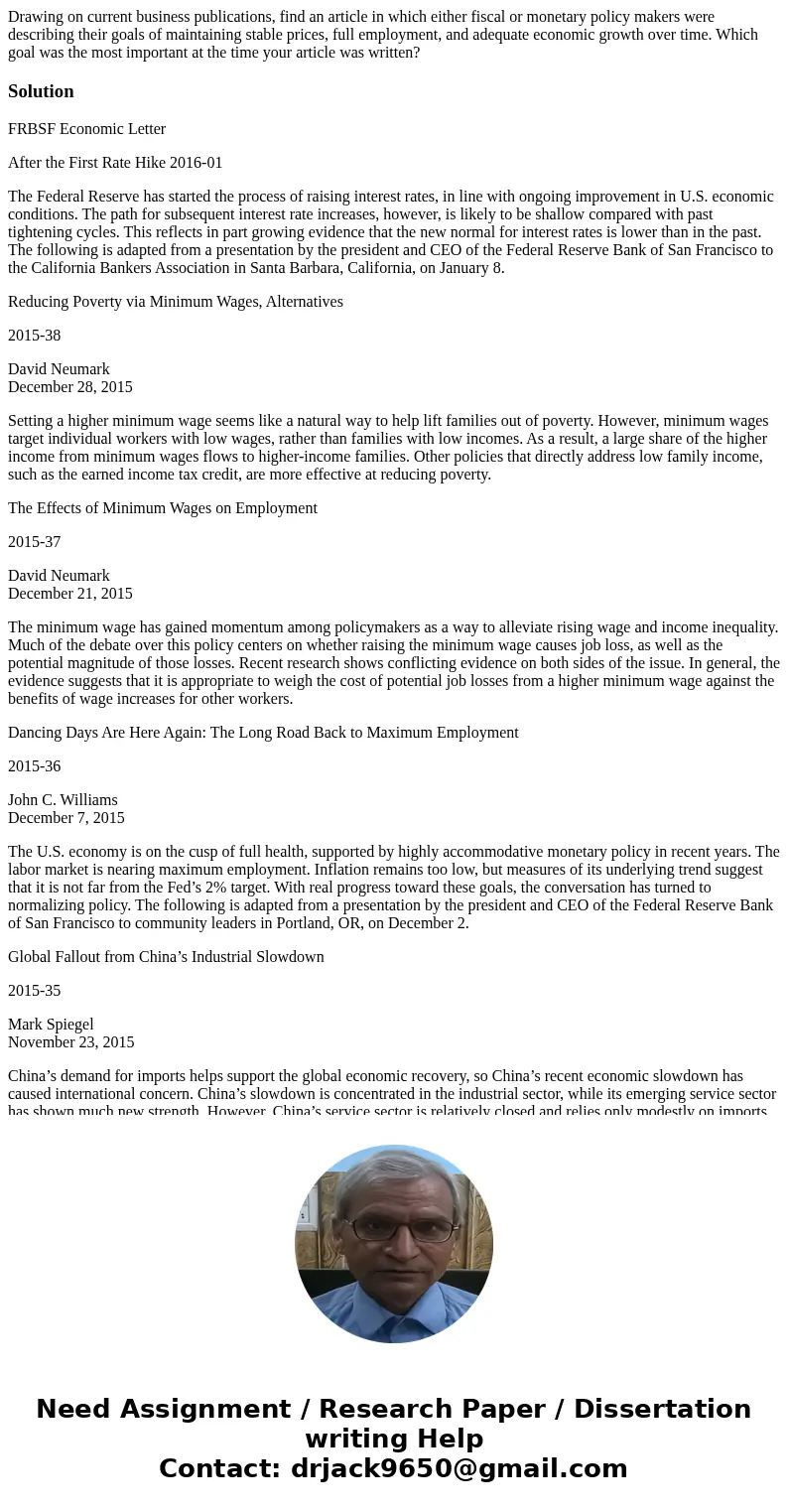
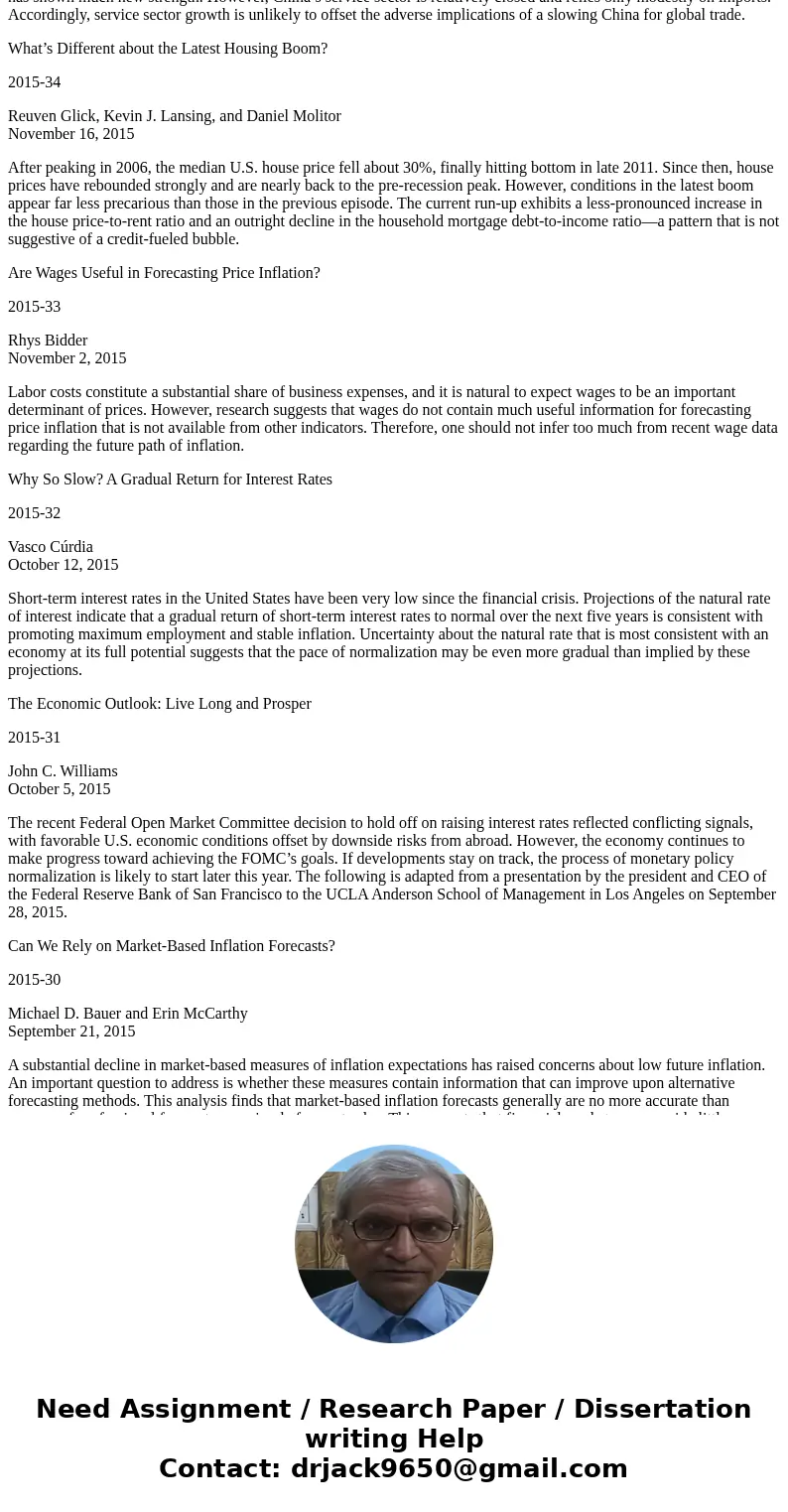
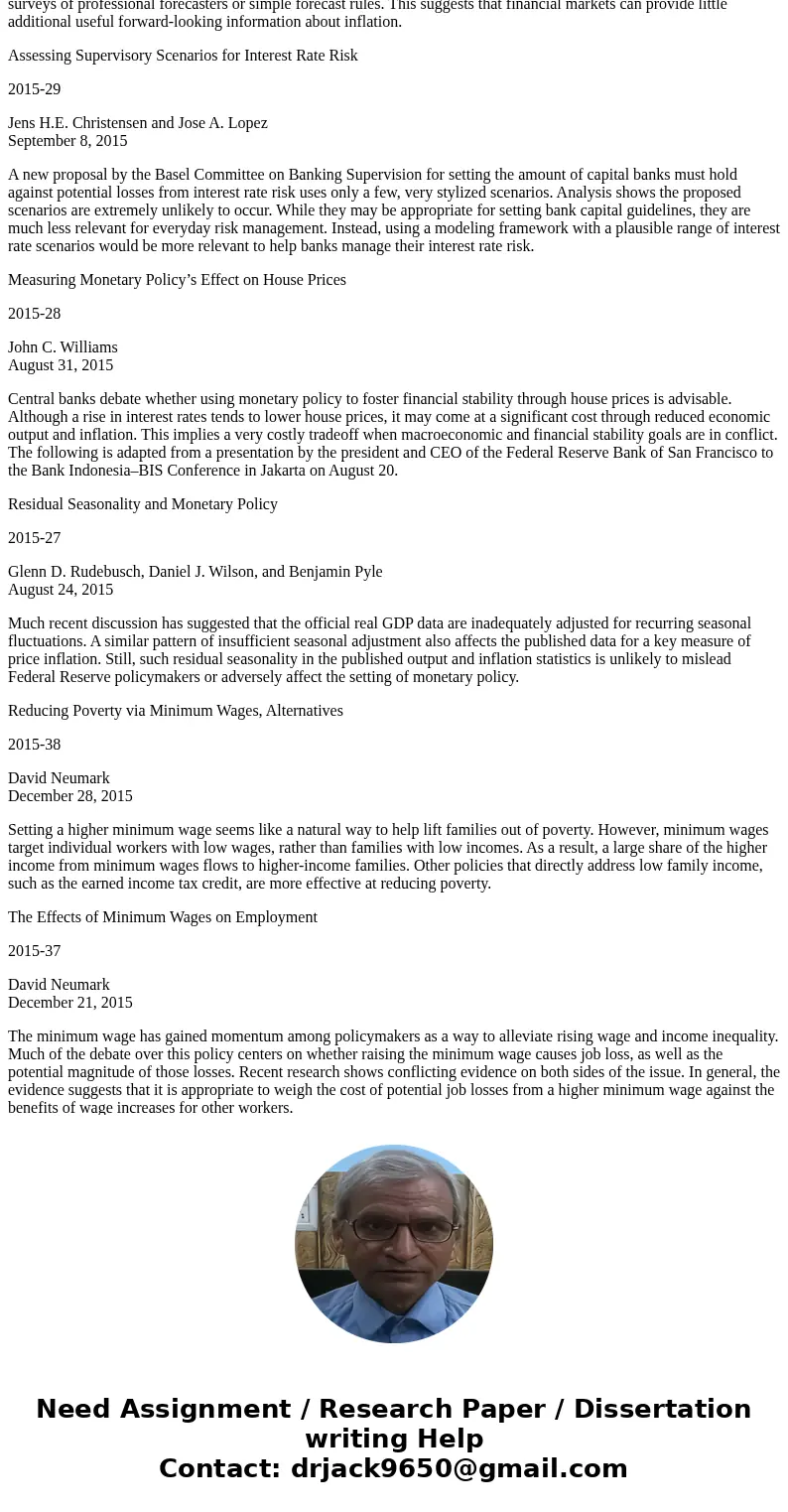
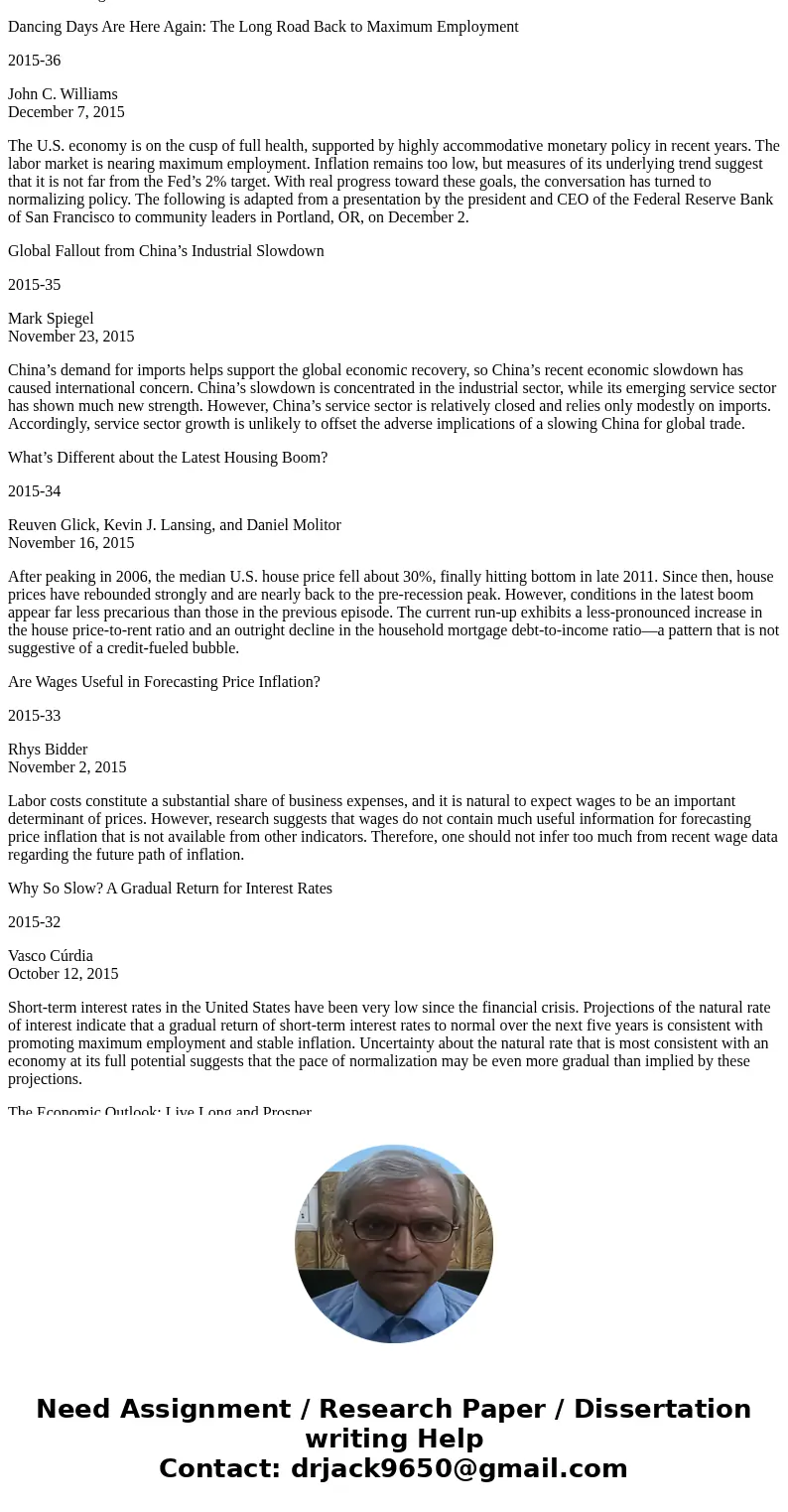
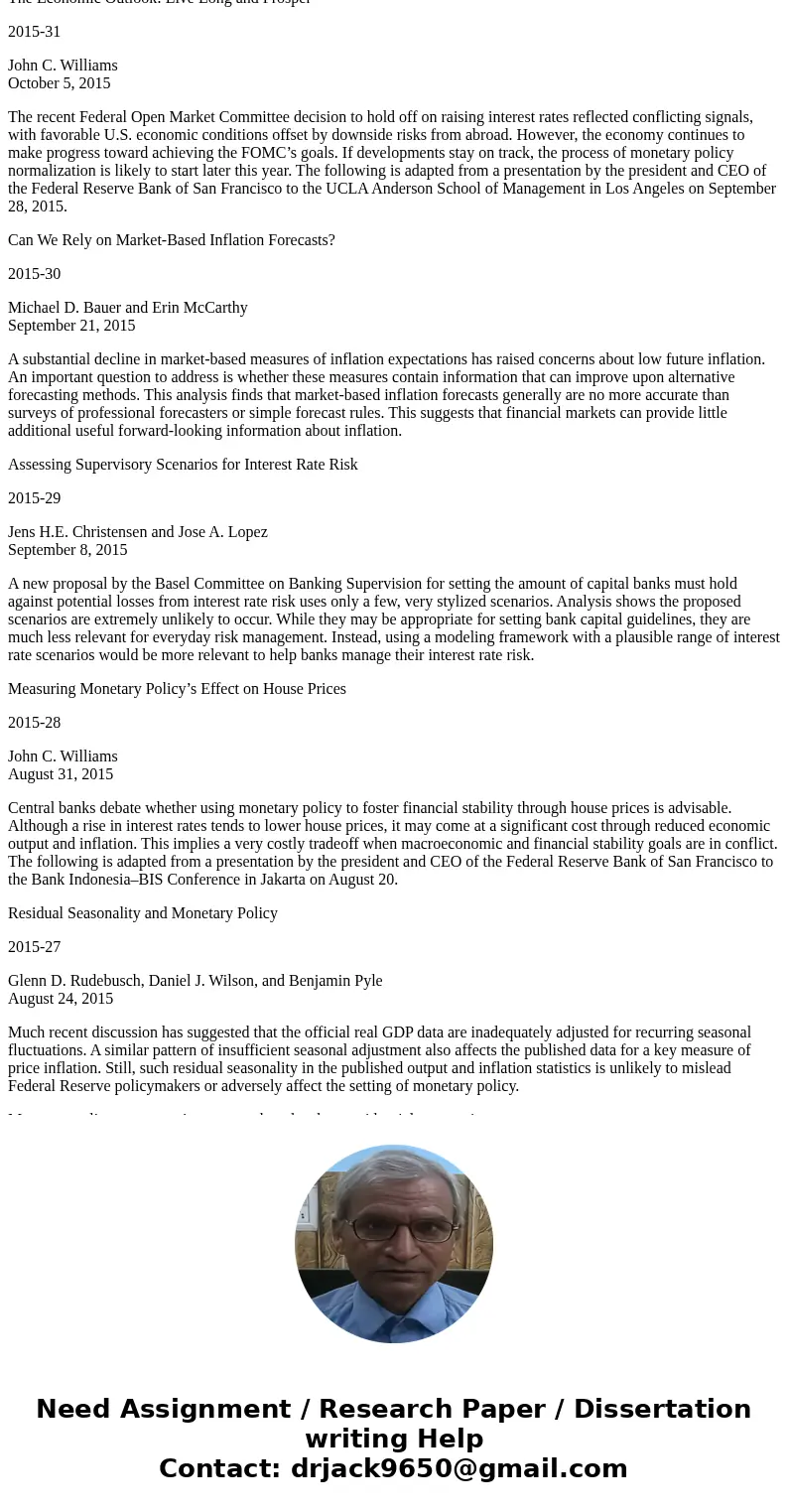
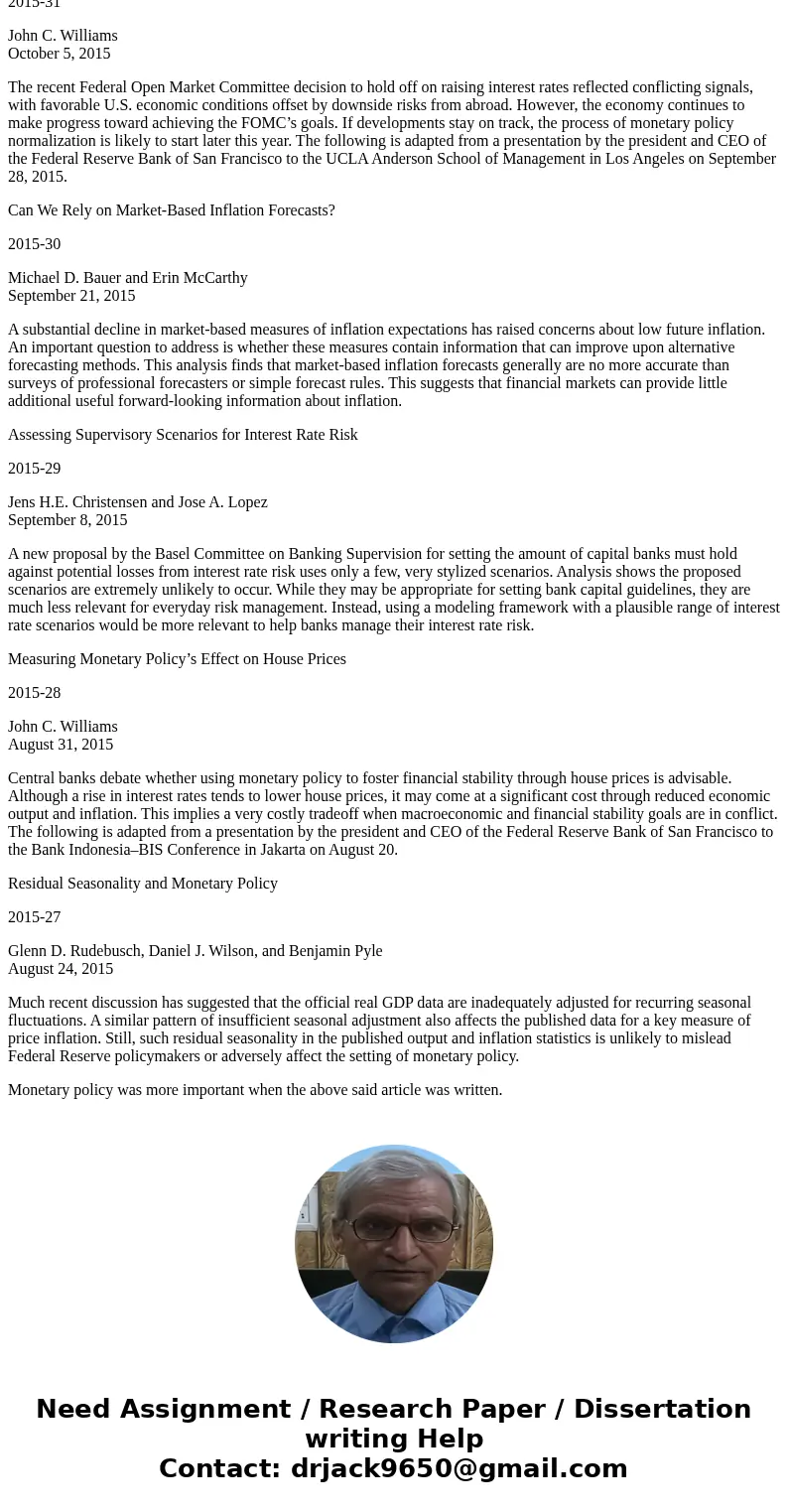
 Homework Sourse
Homework Sourse